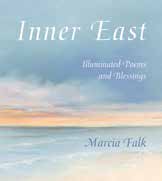Tag : Inner East
January 16, 2020 by admin
Prayer, Illuminated

I’ve never been a morning person, but not long after moving into an apartment with large windows facing the rising sun, my life changed. I would instinctively wake up to watch the colors gradually brightening from midnight blue to the dawn’s splashes of pinks and purples across the horizon. As the metallic magenta ball rose in the sky, I would sing Modeh Ani, the morning prayer of thanks. As my living room became awash with golden light, I would pray with more fervor than ever before, knowing my day is a gift, one I took for granted a little less today.
In the first tractate of the Talmud, the volume of Berachot, “Blessings,” that debates the hows, whys, and whens of prayer, the Rabbis discuss the where of prayer, instructing people that no matter where they are, they are to “direct their heart” towards the Holy of Holies in the Temple in Jerusalem. Even when physically incapable of facing that direction in body, the “orientation of the heart,” kivun libo, is paramount. I considered this when reading the introduction by Marcia Falk to her gorgeous collection of illuminated poems and blessings, Inner East (Oak & Acorn Press, available at https://www.marciafalk.com/innereast.html). In her introduction, Falk describes how her lifelong dream of pairing her visual art with her already popular poetry and prayer collections (The Book of Blessings, 1996, previously reviewed in Lilith, was endorsed when she recalled the time-honored tradition of placing a Mizrach sign (“East” in Hebrew) on the east wall of synagogues in Western countries, to indicate the direction of Jerusalem. A heart-orientation reminder, if you will.
It reminded me of my morning sunrises, and how a visual reminder of the awe-inspiring nature of the Divine enhances my prayers with every cue. In the introduction, Falk notes that the words zericha, “sunrise,” and mizrach, “east,” share root letters. The mizrach pnimi, the “inner east,” is the place where the self rises, from where it radiates.
Although the book is technically divided into two sections—Poems “The Earth and Its Fullness” (a direct quotation from Psalms) and Blessings “Of World and Time,”—the truth is every poem reads like a blessing or prayer, and every blessing is a poem.
“We Know Her,” a resounding prayer to the “her” that is Spirit, the Divine, God, or Goddess, reads like a mystic’s spiritual wanderings, encountering the Divine in every step in nature.
We breathe her as she lifts to the sky
the scents of the newly furrowed field,
and feel her touching our forehead
in our fevered dreams.
Poems of earth, clouds, wind and community meet prayers that echo the traditional liturgy of old, with language that is shaped just as beautifully as the accompanying visual landscapes.
It’s this beauty of language and encapsulation of meaning that has made Falk’s original Book of Blessings a reference point for me in those sacred morning moments, during uninspired evenings, or before preparing to lead a prayer service. (Two years ago, on its re-release, I listened to Falk at Romemu in New York City laugh and breezily discuss her prayer practice, God as feminine, and the importance of keeping services short (shock! horror!). That earlier book’s evolution into Inner East blossomed from a decisive turn—after the original Book of Blessings publication, coinciding with the author’s fiftieth birthday—to return to visual art, pairing her two lifelong passions of writing and painting.
The morning blessing, accompanying a glorious sunrise painting and Hebrew words closely aligned to a traditional liturgical prayer, Nishmat, “the breath,” is simple, divine, every word carefully balanced.
The breath of my life
will bless,
the cells of my being
sing,
in gratitude,
reawakening.
For those already in love with Falk’s artistry through carefully chosen words, in both Hebrew and English, that build on and expand the framework of traditional prayer with inclusive, egalitarian language, vivid descriptions, and evocative descriptions of nature, it is a treat to witness these delicious phrases alongside gorgeously crafted paintings, reproduced in full color in a prayerbook that merits upgrading to coffee table status. Transforming the art of prayer into vivid images of color is a reminder that no matter where we are, all it takes is a small cue for us to guide ourselves to our own Mizrach, to our Inner East.
RISHE GRONER loves to pray. Her writing can be found on www.thegene-sis.com and on Instagram @thegenesisters.
- No Comments
 Please wait...
Please wait...